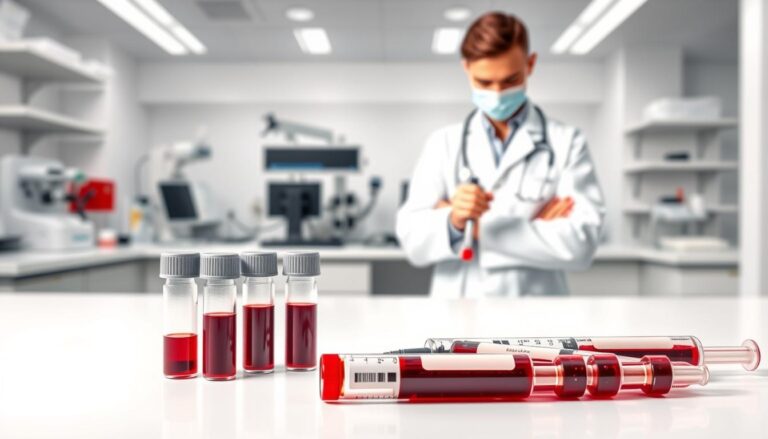Quality Assurance in Blood Testing: Step-by-Step Process
When we talk about blood test quality assurance, a big question comes up. What steps can we take to make sure blood test results are accurate and reliable? How do the best quality control measures affect laboratory testing quality assurance? We’ll look into the process of blood testing accuracy standards and medical test quality assessment to give you a full guide.
Quality assurance in blood testing is about making sure test results are accurate and reliable. This is key for making good medical decisions. It highlights the importance of strong laboratory testing quality assurance, blood test acronyms, and strict blood test quality assurance protocols.

Understanding the importance of blood testing accuracy standards is vital. By implementing quality control measures, we can lower errors. This makes sure test results are trustworthy and reliable. It’s essential for patient safety and effective medical care, highlighting the need for solid blood test quality assurance and medical test quality assessment protocols.
Understanding Blood Test Quality Assurance Fundamentals
Quality assurance in healthcare testing is key for accurate blood test results. The accuracy of blood tests is vital for medical diagnosis and treatment. Standard operating procedures in laboratory testing help improve this accuracy.
Quality assurance for blood tests includes several important steps. These include regular equipment checks, staff training, and following regulatory standards. By doing this, healthcare providers can lower the need for retesting. This also reduces legal and ethical risks and ensures consistent data.
Some key statistics show why quality assurance in blood testing is so important:
- Good quality assurance can cut retesting needs by up to 30%.
- Following rules and guidelines can lower legal and ethical risks by about 25%.
- Quality assurance can also save 15% in costs related to repeat tests.
By grasping and applying these quality assurance basics, labs can make sure blood test results are accurate and reliable. This leads to better healthcare outcomes for everyone.
Key Components of Blood Test Quality Control
Getting accurate blood test results is key for medical care. Labs must use strong quality control steps. This includes pre-analytical, analytical, and post-analytical checks. These steps help make sure test results are trustworthy.
It’s important to watch how precise blood tests are. This helps avoid mistakes and keeps patients safe. Labs follow standards to keep their results reliable. We need to focus on making blood tests as accurate as possible.
Pre-analytical Quality Control Measures
Pre-analytical steps are vital for blood test accuracy. This means collecting, handling, and preparing samples right. Labs follow rules to avoid mistakes and ensure samples are good quality.
Analytical Phase Quality Assurance
The analytical phase is when tests are done. Quality checks here are key to avoid errors. Labs keep equipment in check, train staff, and calibrate tools regularly.
Post-analytical Quality Management
After tests, results are reviewed and interpreted. This is a critical step for accuracy. Labs use quality control here to catch and fix mistakes, ensuring results are top-notch.
Documentation and Record Keeping
Keeping records is a big part of blood test quality. Accurate records help labs track results, spot mistakes, and fix them. This ensures test results are reliable and consistent.
Implementing Blood Test Quality Assurance in Laboratory Settings
Ensuring the accuracy of blood test results is key. This requires a detailed approach. It includes training staff, maintaining equipment, and following regulations.
Staff Training and Certification Requirements
Training staff is vital for quality assurance in blood tests. They need ongoing education to stay up-to-date. Regular checks help identify who needs more training.
Equipment Calibration and Maintenance
Keeping equipment in top shape is essential. Regular checks and maintenance prevent errors. This ensures test results are precise.
Some important steps for equipment care include:
- Preventive maintenance documented for all equipment
- Regular checks for equipment malfunction
- Timely replacement of worn-out parts
Quality Control Monitoring Systems
Quality control systems are critical. They check the accuracy of test results. This helps spot any mistakes or issues.
| Quality Control Aspect | Description |
|---|---|
| Internal Quality Control | Regular checks on equipment and test results |
| External Quality Assessment | Participation in external quality assessment programs |
By following these steps, labs can ensure accurate results. They meet high standards of quality.
Conclusion: Ensuring Sustainable Quality in Blood Testing
At the core of delivering precise blood test results is our dedication to quality assurance. We must keep setting up strong quality assurance protocols and strict quality control measures. This ensures the reliability and consistency of lab tests. By sticking to top laboratory testing standards, we maintain the highest blood test accuracy. This builds trust among healthcare professionals and patients.
It’s vital to regularly check and review test outcomes to spot areas for betterment. By embracing detailed quality assurance practices for blood tests, we foster a culture of excellence in diagnostics. This protects patient health and aids in making informed medical choices.







